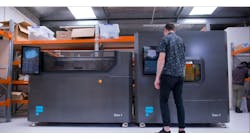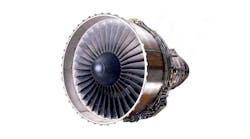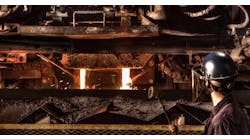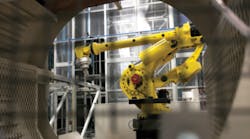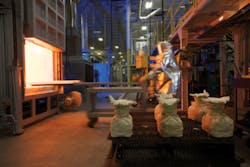Casting buyers are “in awe” of what they see at the new Chromalloy Castings plant in Tampa, according to Tom Trotter, the vice president and general manager of that 1 million lb/year investment casting operation. These are a demanding set of customers, representing the aerospace engine and industrial gas turbine markets, and their standards for quality and precision in the turbine blades and vanes they order is an insight to the processes and performance it takes to impress them.
The $30-million, 115,200-ft2 start-up has been a fairly rapid development. The project was announced in 2009 and completed in 2010. Production was launched last May, and over the following months Chromalloy migrated its business from its former location 14 miles away, until finally consolidating all operations at the new plant in October. In December, on the occasion of the new plant’s ribbon-cutting, Chromalloy announced it will add a $5-million, 40,000-ft2 plant adjacent to the investment casting foundry, to produce ceramic cores.
For all the enthusiasm, Chromalloy Castings is not a new enterprise, and not new to metalcasting. It is the largest business unit of Sequa Corp., which also has holdings in the automotive supply chain and metal coil coating. Chromalloy Corp.’s primary market is the commercial airline sector, to which it has been supplying a range of aftermarket products and services for over 60 years. With locations in 17 countries, it is the world’s largest independent supplier of hot-section parts for jet engines.
In addition to casting, the Chromalloy “value chain” covers product design, production of tooling, cast product machining, coatings, and repair service. The global organization supports turbine engine operators, notably commercial airlines, in particular the high demand for replacement parts.
About 20 years ago Chromalloy acquired the former Aerodyne Investment Castings Inc. in Tampa and, according to Trotter, it “began to develop the techniques that we use to manufacture OEM and aftermarket parts, for both aerospace and IGT.” (Chromalloy has a smaller investment casting operation in Carson City, NV, too.)
Today, he estimates that 80% of Chromalloy Castings’ business is “internal,” that is, supplying investment-cast turbine blades, vanes, and other parts to the Chromalloy organization’s repair and service centers around the world, and to a joint-venture parts supplier it maintains with three airlines. The remaining 20% is supplied to aerospace and IGT engine OEMs.
In both sectors, the demand for replacement parts has more than doubled in the past two decades, with a corresponding rise in the value of the parts. Also, as the OEM engine builders have consolidated their holdings, the aircraft and power-plant operators recognize a need for an independent source of quality replacement parts.
A plan emerged about two years ago, Trotter recalled, to increase the casting capacity and capability of Chromalloy’s Tampa operation. That former plant was designed to pour about 300,000, lb/year, and it was an effective source of aerospace engine parts, he said. But, it was not capable of producing larger parts for the power-generation market. In particular, the old plant was not suited to a proper production flow for Chromalloy Castings’ plans. “So,” Trotter explained, “it didn’t have a lot of capacity, and it didn’t have the capability to make the large parts. And, that’s what we get with this new facility.”
Production Flow
The new plant was laid out in a modern building 14 miles away from the former site. While some operating equipment was relocated, the $30-million investment covered three new, large casting furnaces: two for directionally solidified (DS) and single-crystal oriented castings, and one for equiaxed castings. “They have very large size envelopes, and they have about 300 lb of pouring capacity,” Trotter reported, “and for our industry they’re capable of producing very large parts.”
There are now six DS furnaces (top pouring capacity 300 lb) and two equiaxed furnaces (also 300 lb), and the new furnaces provide three-times as much melting capacity for DS and single-crystal products, and twice the capacity for equiaxed capacity as Chromalloy had previously.
The investment castings produced range in size from just a few inches up to 30 inches tall. Most are nickel- and cobalt-based super-alloys, though a few stainless steels are cast, too.
The production process starts from CAD models that are sourced throughout the Chromalloy organization, which are converted into steel injection molds at Chromalloy Tooling in Los Angeles.
At Tampa, those molds are injected with wax to create patterns, which are assembled and dipped into ceramic slurry to create the ceramic shells. In addition to more than doubling its shell capacity from 60 to 150 per day, Chromalloy boasts that the new plant’s shell line “redefines state-of-the-art process control.” Trotter maintained that much of that process is proprietary information, but he allowed that it has been developed “to eliminate some of the problems that historically have plagued shell lines.”
The purpose is to control temperature and humidity throughout the shell line process to prevent problems like over-drying or under-drying. “We get a very consistent drying level,” he explained, “and we utilize four different drying zones to be able to dry at different rates through different steps of the process, and really to customize the drying process to the configuration of the part.”
These steps are tied together with a control system that allows Chromalloy to monitor different aspects of the shell process in real-time, and adjust accordingly, for maximum control and productivity. “So, for example, if I’m running a large IGT part,” Trotter detailed, “and the next mold happens to be a small, aerospace part, within the same shell line I can tailor the process so that I optimize it for those two parts, without having to reconfigure the system.”
That flexibility is valuable once the molds arrive at the casting stage, where Chromalloy Castings has the wide range of melting options that its high-tech customers require. Because most of the metals it pours are potentially unstable nickel- or cobalt-based superalloys, vacuum induction melting is the furnace process of choice.
Typically, the VIM process involves placing a preheated mold into the lower chamber of a furnace, while the upper chamber is kept under vacuum. That upper chamber, the melt chamber, features an induction coil surrounding a crucible in which a supperalloy charge is melted. An isolation valve separates the two chambers, and after the mold is preheated the vacuum is extended to the lower chamber and the mold is raised up to be filled with molten metal from the crucible.
Once the mold is filled it is drawn into the bottom chamber for solidification to begin. Solidification varies according to the process: In the equiaxed process Chromalloy Castings can fill a mold every 10-15 minutes, Trotter said, while the DS and single-crystal processes may require solidification times of two to three hours. The size of the part also influences solidification time.
“I think what (the customers) see that differentiates us quite a bit is our technology, our intellectual property, and our housekeeping,” Chromalloy Castings vice president and general manager Tom Trotter explains. “Our standard for housekeeping here is ‘hospital’ — neat, clean, and organized.”
The differences in the processes pertain to the metallurgical grain structure of the alloys in the finished part, which may be critical to its performance in the customer’s application: Equiaxed parts exhibit thousands of symmetrically aligned grains, randomly solidified. DS parts, such as turbine blades, are produced in a more carefully controlled process that forces the strongest grains to grow up through the part in a longitudinal direction, so that they form an elongated shape extending in the direction of the blade. Single-crystal parts are produced with even more control during solidification so that the grains form a single structure through the length of the part.
Notwithstanding the higher volumes of production at the new plant, one of its virtues is the efficiency of its product flow — less than 2,000 feet in total versus greater than 5,000 feet at the former location. And, Chromalloy Castings is able to maintain product lead times of less than four weeks now, as opposed to 12 to 16 weeks previously.
All of the production processes are supported with quality control capabilities, including a full ceramics and metallurgical lab, and equipment for mechanical testing, materials testing, including scanning electron microscopes. “The technology that we’ve invested in that lab is invaluable in making sure that we’re able to maintain the very, very high quality standards and FAA requirements that we have to maintain,” according to the plant’s general manager.
Quality Control
That degree of control is reflected more widely in the organization and management of the plant. It is managed with purpose-built programs derived from the Lean and Six Sigma approaches, with continuing process control and improvement objectives. As important, all of Chromalloy Castings’ products carry ISO 9001:2002 and AS9100 certification, and its operations are NADCAP-certified for NDT, heat-treating, and welding. And, all its aerospace parts are FAA-certified as equivalent or better to OEM parts, an effective message to the MRO aftermarket.
Trotter is pleased to add that customers and other visitors find it to be “unlike any facility in the world.
“I think what they see that differentiates us quite a bit is our technology, our intellectual property, and our housekeeping. Our standard for housekeeping here is ‘hospital’ — neat, clean, and organized,” he continued.
“Even though investment casting is typically much cleaner than a sand casting facility we’ve taken it a step further. Our thought process is that we start with housekeeping discipline, and if we can keep that right then it makes process control discipline a bit easier. And, then if we get that right then all the rest of the disciplines will fall into place.”
One change ahead will be the on-site availability of ceramic cores for investment casting, once the just-announced plant starts up in 2012. The cores are critical for producing the complex internal passages that many turbine vanes and blades entail. The cores are produced from ceramic slurry injected into steel dies, solidified, and subjected to a series of firings to enhance crystallite growth to strengthen the core’s structure. Some finishing operations may follow, too.
Chromalloy Castings has some coremaking capability at the Nevada site, but the expansion in Tampa will make it one of the few investment casting plants in the world able to produce ceramic cores on site, according to Trotter. It also will be the only investment casting plant in the world with the ability to develop cores for the entire range of aerospace and IGT engine components.
Up to Speed
Since it started operating last May, the Tampa operation is “fully up to speed now, producing 100% of our production requirements,” Trotter said in late January. That includes an increase in production he estimated at 50% since the December grand opening, but the plant’s producing levels will continue to increase. He indicated that Chromalloy Casting will be raising output again this month, and next month, “so that by the end of this quarter we should be at a clip that supports the growth we’re working on …”.
In time, that could mean adding capacity as needed, Trotter allowed when asked about further expansion plans. But, noting that Chromalloy Castings has already tripled its pouring capacity and expanded its shell line capabilities, he emphasized that the new Tampa plant’s purpose is to ensure that Chromalloy’s global service and supply depots have the parts they need. “That way we can keep the technology focused and in control, and supply the parts that Chromalloy needs to grow,” he concluded.

